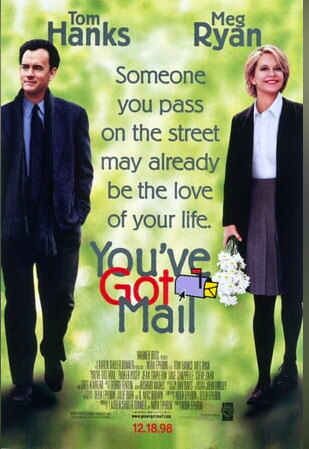Five Steps to Successfully Switch Your Freelance Niche
By Jena Kroeker
The year is 1998. For some of you, your freelance niche is a mere twinkle in your eye, and the idea of switching it has not yet materialized. But as many of us watched a movie called You’ve Got Mail, little did we know it provided a valuable illustration of how to switch our niche and adapt our services to suit industry demand.
Cast your mind back to that magical time in the late ‘90s, when many computers proudly announced “You’ve got mail,” every time an email arrived. In the movie of the same name, Meg Ryan plays the owner of a small boutique children’s bookstore called The Shop Around The Corner, a business she inherited from her mother. Meanwhile, her business rival, played by Tom Hanks, opens a lower-priced big box bookstore across the street, named Fox Books, which ultimately affects her store’s profits.

Screenshot via WarnerBros.com
Sadly, Meg Ryan’s character realizes her business is no longer sustainable. But rather than give up on books entirely, she discovers she can adapt her niche. Instead of selling children’s books at her store, she can write them herself. She maintains the core element of her passion as she changes her focus.
Can you relate to this situation? Maybe you’re at a crossroads too, where you need to figure out whether to continue with your current services or change them to ensure the survival of your freelance or virtual assistant business. Let’s explore some of the reasons that may lead to this decision.
How to Know When It’s Time to Make a Change
In a previous podcast episode, “The Changing Your Niche Class,” FreeU co-founder Craig Cannings further discusses how You’ve Got Mail illustrates the need to switch gears in a business when you come to a crossroads, and he suggests a number of warning signs that alert us when it’s time to make a change.
As we explore the following examples, do some self-evaluation to see whether you relate to similar situations in your own freelance niche.
1. Your work opportunities are diminishing.
Although business was booming in the past, suddenly it’s like sand slipping through your fingers. You notice that some of your regular clients are canceling your services, and it’s getting harder to land new clients.
As an illustration, two key changes happened to my original freelance niche many years ago. First of all, companies started preferring the task be done by in-house employees instead of remote freelancers. Next, a recession hit and decreased the number of job opportunities in that particular niche. Clients had to cut back on the amount of work hired out.
When this happened, I had to decide what was more important to me — the niche itself or the environment I was working in. I could have kept my freelance niche and switched to working as an employee at a company, but I decided I liked the freelance lifestyle, especially the freedom to work from home. Fortunately, I had other transferable skills I could use and develop, so I chose to switch the niche.
2. Your passion for your freelance niche is waning, leading to burnout.
Maybe it starts with the word “Ugh.” You used to enjoy receiving work from your clients, and suddenly you think “Ugh” every time you’re asked to perform a certain task. And this feeling doesn’t go away. On the contrary, it steadily builds, until you dread getting up in the morning and facing your computer. Over time, you become increasingly tired of your work.
To address this issue, Sally Miller shares some key advice in her podcast episode, “When To Change Your Business Niche.” She suggests switching or pivoting after testing your niche for at least three months, once you’re sure you don’t like it. And she describes an underlying reason why you might lose passion for your work:
“… you genuinely no longer love the idea of helping your people. And that’s usually because you’re feeling out of integrity. You are no longer aligned. Perhaps you have grown and changed so much as a person that this problem, this audience, no longer feels genuine to you. It no longer feels purposeful; you no longer feel called to do it. To me, that is the one and only time when, yes, it is a good idea to change business niches.”
Indeed, as Craig Cannings says, if you consistently do work you don’t love, you’ll burn out and lose sight of why you started freelancing in the first place.
Note:
Sometimes it’s not the freelance niche itself but the clients you’re working for who cause your passion to wane. For instance, maybe the audience you’re working with now is not who you want to work with long term. In that case, if you’re still enjoying the work itself, you don’t need to change the types of services you’re offering.
Instead, adjust your marketing activities to appeal to a new target audience. Brainstorm a list of ideal clients you’d love to work for who could also use your freelance or virtual assistant services. Then, research where they’re hanging out online or at in-person networking events so you can reach out to them.
3. Your earning potential has plateaued, and you’re stuck in a rut.
As mentioned above, sometimes you don’t necessarily need to change your freelance niche. In some cases, you can get out of a rut by simply adjusting your marketing strategies, redesigning your website, or engaging in networking activities to make your work more enjoyable and profitable. But if you’ve explored those avenues and still notice you haven’t earned more money during the past year or two, it might be time to change your services.
In an article titled “How To Pivot Your Niche,” Aislynn Palmer suggests following this advice before making a significant change:
“Pivoting your niche should be the last resort after you’ve exhausted all other options. If you’re multi-passionate and still struggling with your current business niche, then a pivot or niche switch might not be what you need. Instead, you might want to consider addressing the real issue your business is facing, which mainly boils down to traffic, leads, or sales. Addressing the real problem is crucial because taking ‘you’ to the next niche means that you’re likely to face the same problem you’re facing in your current industry or niche. Consider giving your business the necessary effort and time it requires to notice results because, let’s face it, businesses take time to build, including online ones.”
Five Steps to Successfully Switching Your Freelance Niche
In the podcast episode mentioned above, Craig Cannings outlines five key steps to help you successfully transition to a new niche. These steps could involve subtle changes or big ones that lead you to completely new business services.
1. Assess your current offerings and service niche.
First of all, ask yourself the following questions:
• What do you like about your current niche?
• What part of the work you’re doing right now is robbing your joy and making your life difficult?
• What tasks are you doing that you absolutely don’t like anymore?
• What changes could you make to create a more viable niche right now?
And as you consider possible changes, identify whether you need to make a big change or a more subtle shift, like adjusting the scope of services you’re offering so you can specialize in the areas you enjoy while removing less enjoyable ones.
For example, if you’ve been working as an editor or proofreader for many years and are tired of doing the hands-on work, maybe you’re ready to teach or mentor others. You could develop online courses to share your experience and grammar skills. Or you could scale your business by bringing on team members to provide editing and proofreading services while you offer teaching and mentoring services.
In a previous FreeU blog post titled “How to Select a Niche Focus for Your Freelance Business,” Connor Gillivan puts it this way:
“So now, ask yourself what you really love doing. What would make you smile first thing in the morning as your mind begins to focus on the tasks ahead of you? What would keep you so energized throughout the day that you’re just so happy doing it from sunup to sundown?”
2. Evaluate your fit with your current target audience.
To determine whether you need to change your target audience, ask yourself these questions:
• Do you enjoy working with your current audience?
• Are there still opportunities with your current audience?
• If not, what audience would you best serve?
If you feel like you’re in a rut or not enjoying the type of work your audience does, you may want to reach out to a different market. For example, instead of proofreading or editing articles and blog posts for business owners, you may decide you’re interested in working with book authors or course creators. In this case, performing the same tasks for different clients could invigorate your business and ignite your passion again for the tasks.
As the article above says,
“Picking your target audience is an integral part of your business’s marketing strategy, and this is because every single action you execute throughout the process is essentially based on your audience. However, sometimes your business grows and evolves, and it becomes necessary to shift gears or pivot your niche and start targeting a new audience for further growth.”
3. Consider amplifying your existing niche.
What additional services could you add on to your existing freelance niche? Sometimes you may not need to get rid of your current services; instead, you could simply amplify what you’re already doing. For example, if you’re a podcast editor, you could add show notes and graphics to your tasks, helping your clients promote podcast episodes on their website and social media platforms.
In this case, identify a need your client has that would be complementary to the existing services you’re already providing. You can come right out and ask clients if they’d like you to perform these additional tasks. Or you can “show your worth” by demonstrating your skills first in an online portfolio or in social media posts.
As an illustration, when I wanted to add writing services to my editing and proofreading services, I started a blog, wrote a Christmas newsletter, and shared my work as much as possible on social media. This led to current and potential clients providing feedback on my writing and in some cases requesting my services without my having to ask them.
4. Research new niches that might interest you.
If a subtle change isn’t enough, now’s the time to think outside the box and brainstorm options. For instance, like Meg Ryan’s character, you could go from being a bookseller to being an author. When a big change is what you need, use the following strategies:
• Find out what type of work is available in different niches. (e.g. Content writing services can include ebooks, free offers, blog posts, articles, etc.)
• View websites to see what other freelancers and VAs charge for their services, and consult resources like FreeU’s Freelance Pricing Guide.
• Research what types of clients are served by freelancers and VAs working in different niches.
• Take classes to see what services might best suit you. You don’t know if you’ll enjoy a task until you start learning more about it and practicing it.
• Enlarge your vision to include services that might be completely different from the core service you’re offering right now.
And be encouraged by this quote from the article above:
“… don’t be afraid to blaze your own path. Did you know that just 40 years ago there was no such thing as a knowledge broker? But Tony Robbins made it a thing, building that niche from scratch and growing with it to heights most of us can only dream of. Today, there are tons of people around the world making an excellent living doing what everyone back then said Tony was crazy for trying (and that he should get a ‘real’ job!).”
5. Test the niche and see where it takes you.
Choosing a new niche can be scary, especially if you think you’re stuck with it indefinitely. That fear can hold you back and trap you in a state of indecision. So, throw off those shackles and remember Craig Cannings’ wise advice:
“Just because you change your niche, it doesn’t mean you’ll be stuck in it. The reality is, in our rapidly evolving freelance economy, you’re going to need new skills six months from now. You’ll probably be changing niches a year from now. That’s how fast-moving our industry is. We can adapt and shift on the fly as needed. Figure out what you should be doing today, not what you need to be doing a year from now because that might look entirely different.”
And if you’re worried that changing your freelance niche will have an adverse affect on your business, consider Natalie Hodson’s advice in her article, “Can You Change Your Niche?” She shares these words of wisdom:
“If you’re changing the name of your business as you shift your niche, you’ll experience some financial dips as you change the name legally. You’ll have to do a lot of new branding and creating new content. There will be dips, but I wouldn’t say these things will hurt your business. You’ll have to decide if changing your niche is worth it to you. Will there be financial dips, a loss of customers, and lag time as you shift? Yes. But if you’re more passionate about a different niche, then maybe you’re willing to go through the down slope before going back up.
“And let me tell you, you’ll do more work and be happier in something you feel closer to.”
Final Thoughts and Encouragement
As Craig Cannings says, “One of the greatest success traits for any freelancer is your willingness to adapt when you need to,” and this includes making big or small changes to your freelance niche.
The movie poster for You’ve Got Mail shows the tagline “Someone you pass on the street may already be the love of your life.” Similarly, the freelance or virtual assistant services you see someone else doing may already be the right niche for you. So, keep your options open, do some serious self-evaluation, and don’t be afraid to switch your niche when the time and circumstances are right.
Have you changed your freelance or VA services? Or are you considering a change now? If so, what were the warning signs that prompted you to make a switch? And what strategies did you find most effective in ensuring a smooth transition? Please share your thoughts and advice in the comments below.









































































































